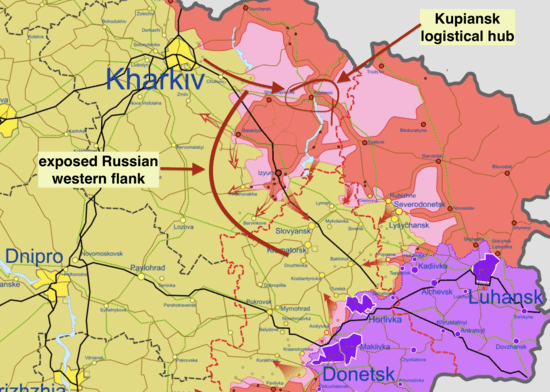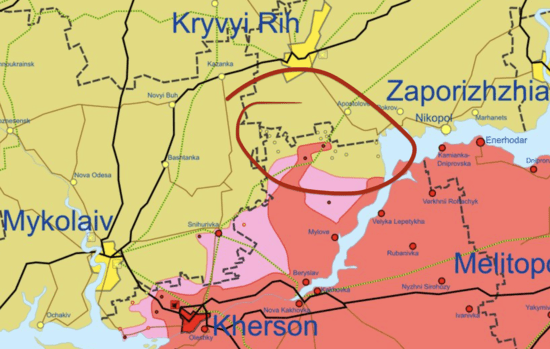Ukraine update: What we learned from the first day of Russia's big Donbas offensive
This post was originally published on this site
Season two of Putin’s war in Ukraine is now underway, and while it’s early, we’re starting to get an idea of Russia’s designs. Say goodbye to a push toward Dnipro (the notion was idiotic), and so long pipe-dream pincer—a 200-kilometre attempted encirclement of Ukrainian defensive positions on the eastern Donbas front—that was stupid too. What we’re getting instead is the same shit from the last eight years: direct attacks on the entire Donbas front lines. It looks like this:
Not only is the entire front under pressure, but the Izyum salient is pushing toward Slovyansk (pre-war population 111,000), and Kramtorsk (population 157,000). The pincer maneuver would’ve aimed to cut off Ukraine resupplies to this entire region, starving a third of Ukraine’s army into submission. Perhaps after Mariupol, which still hasn’t fallen, Russia decided that would take too long—parades must be marched on May 9 after all. So Russian troops are gunning for the region’s two major population and cultural centers, cutting them off from supplies, and maybe attempting a Mariupol-style operation to take them.
For once, a Russian move doesn’t appear utterly idiotic. This is what they should’ve done at the start of the war when they were at full strength. Russia can’t maintain long supply lines. This minimizes that deficiency while also making them less vulnerable to Ukrainian artillery hitting them hard from the west. And broad pressure across a wide line means they can keep doing their small-scale advances without having to figure out how to mass forces for a major singular push. In other words, it’s making lemonade out of lemons.
The amount of territory exchanging hands was minimal, but of course it’s early.
So Russia is making the best of the hand it’s been dealt, but let’s talk about that hand, because … it’s still not great.
Russia began the war with 120-130 battalion tactical groups (BTG), which have a paper strength of 800-1,000 troops, 1,200 tanks, and around 5,000 infantry fighting vehicles. We’ve discussed at length how most BTGs showed up understrength, and how few soldiers in a BTG are actually combat troops (230, to be exact). The problem has only gotten worse as the war has attritted unit strength (dead, wounded, and destroyed equipment), and soldiers desert and outright refuse to redeploy after fighting in Kyiv, Kharkiv, and Sumy regions. Russia has lost at least 519 tanks and 838 armored fighting vehicles. Those are just publicly available, visually confirmed losses, which means the real number is even higher. So unbelievably, Russia has lost around half the tanks they likely started with, and those were their best, most modern tanks. The stuff coming in from reserve piles is 1960s crap.
The Pentagon thinks another 22 BTGs are currently being rebuilt/retrofitted outside of Ukraine, and another 12 around Mariupol (though the open source intelligence community has only been able to identify around six).
You look at those numbers, and wow, that sounds like a lot! Yet 22 are still hypothetical units, not engaged. Ukraine claims many of these units are refusing orders to deploy, and they’ve released intercepted calls supporting that assessment. Whether it’s six or 12 around Mariupol, they’re still stuck there trying to deal with only 1-2,000 remaining Ukrainian defenders, in a massive city-sized factory literally designed to withstand a nuclear attack (no joke).
So for now, as the big offensive gets underway, we’re talking 76 BTGs. At full strength, that would be 760 tanks, 3,000 infantry fighting vehicles, and 17,480 soldiers. Of course, we’ve seen Russia put all manner of unqualified, untrained soldiers in vehicles, so let’s assume double that were thrown into the wood chipper: that’s still only about 35,000 troops trying to take and hold an area that is hundreds of square miles, with deeply entrenched and protected defensive positions. (If I were Russia, I’d station a garrison outside the factory and move everything else to the north. Not worth the lives, equipment, and effort to root out Ukrainians when they’re cornered in this pocket.)
Of course, we know know that Russia isn’t fielding full-strength BTGs. They never did—the entire concept of the BTG was designed by grifters to make it easier to pilfer material and money—a regiment kept one BTG ready for missions like Syria and stole from the other two for villas, dachas, and vodka. The Russian army was ill equipped to send 120-130 of its total 170 at the start of the war. It’s even worse now. Take this video, for example:
It’s not a gigantic column. It’s a BTG. Except that instead of 40 IFVs, I counted 30 or so. No tanks when it’s supposed to have 10. And as you can see, there are lots of supply trucks, so no matter how many soldiers they force into combat roles from the supply teams, they can’t get them all on the front lines. They need to ferry fuel, ammo, and supplies. They need their mechanics and other maintenance people alive to fix broken gear. Too bad we can’t count soldiers, but already, this BTG is below combat strength (it has lost over a third of its vehicles even before it reaches the front). Not that Russia cares, since it’s just throwing them into frontal assaults without thought of tactics.
With enough artillery, air support, and frontal assaults, Russia might finally punch through some of the prepared lines. Seems kind of inevitable, actually. Then what? They fight their way to Sloviansk and Kramatorsk and once again find what they’ve found in every city of any significant size: Russia doesn’t know how to do urban warfare, and a small, outgunned defensive garrison can tie up Russian forces nearly indefinitely.
The two cities will be reduced to rubble, that we can assume. But that doesn’t end resistance. In fact, it gives defenders more places to hide and ambush the enemy. And these two towns are not Mariupol, isolated, deep in the country’s southeast corner, far from friendly lines. There’s an entire Ukrainian army breathing down their necks just on the western edge of the Donbas region. By most estimates, one-third of the Ukrainian army is in Donbas, which means that most of the rest is right outside the door, preparing to engage.
Meanwhile, Ukraine is on the offensive around Kharkiv, threatening Russia’s supply lines. It looks like this:

Two major rail lines from Russia converge at Kupiansk, as well as another from the Russian-occupied east. Take that out, and that entire Izyum salient is in trouble. Of course Russia is attempting to connect that salient with Russian-held territory in the east, but even if they connect, losing direct access from Russia will dramatically reduce Russia’s abilities to resupply that entire area, and bottleneck their supply lines into fewer roads—both slowing down the pace of supply (traffic jams), and making those convoys easier ambush targets.
My guess is that Kupiansk is too valuable to lose, and Russia will have to move troops north to protect those supply lines. That’s called “fixing the enemy in place.” Every BTG babysitting their supply lines north of the Izyum salient is one less BTG on the offensive down south, just like every BTG trying to dislodge Ukraine from the Azovstal steel plant is one less BTG pushing north.
Please note that I write these late at night before going to bed, Pacific time. Lots can change by the time the morning crew publishes this live. We are definitely in “fog of war” territory here, so I’m using the best available information at the time I write this. On Tuesday, I’ll be digging for details on the specific attacks: Is Russia attacking with larger force, or are they still limited to one or two BTGs per attack? Also, word is that Ukrainian artillery reinforcements are making it to the east in time to engage. Will we see some of the results? If true, that’ll make things particularly unpleasant for Russians on the Izyum salient. I’ll be paying close attention to Kharkiv and whether Ukraine pushes that attack, and whether Russia rushes defensive troops to protect their lines.
As for Kherson down south, Russia is laying down a wall of artillery, preventing Ukrainian forces—lacking sufficient armor and artillery of their own—from traversing that wide-open exposed terrain. I suspect Ukraine will prioritize the eastern Donbas front over Kherson’s liberation for the time being. Still, Ukraine continues to reportedly roll back Russian forces from the Kryvyi Rih approach. The little white circles (look like dots) I circled below are all settlements liberated in the last few days.

One last thought: Russia must really be freaked out about arriving Western arms shipments and Putin’s May 9 deadline, because this attack is coming at a really shitty time: spring rainy season. While the forecast is showing less rain than it did yesterday, it’s still wet season, preventing the ground from drying out.

Russia’s heavy equipment will need to either stay on roads, where they are easy to ambush and target with artillery, or they risk a losing confrontation with General Mud. Not that any of the good guys are complaining, however. Ukraine could use all the help it can get.
